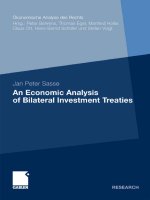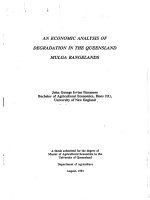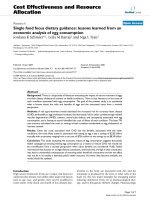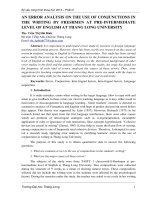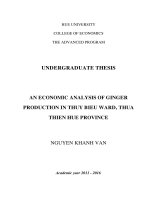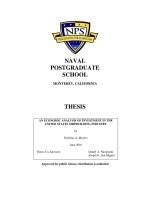An economic analysis of the use of recirculating aquaculture systems in the production of tilapia
Bạn đang xem bản rút gọn của tài liệu. Xem và tải ngay bản đầy đủ của tài liệu tại đây (2.53 MB, 52 trang )
AN ECONOMIC ANALYSIS OF THE USE OF
RECIRCULATING SYSTEMS IN THE PRODUCTION
OF TILAPIA.
FRANK APPIAH-KUBI
Department of ANIMAL AND AQUACULTURAL SCIENCES
Master Thesis 30 credits 2012
MASTER OF SCIENCE IN AQUACULTURE
AT
An Economic Analysis of the use of Recirculating Aquaculture
Systems in the Production of Tilapia
FRANK APPIAH-KUBI
Main Supervisor
Professor Hans Magnus Gjøen
Department of Animal and Aquaculture Sciences
Norwegian University of Life Sciences
Ås, Norway
Co-Supervisor
Bjørn-Frode Ericsson
Department of Mathematical Sciences and Technology
Machine, Process, Water, Agriculture and Product Section
Norwegian University of Life Sciences
Ås, Norway
i
DECLARATION
I hereby declare that this thesis is a bona fide record of research work done by me as a part of my
master degree program from the Norwegian University of Life Sciences (UMB), Ås, Norway.
It has not previously formed the basis for the award of any degree, diploma, fellowship to me, or
other similar title of any other university or society.
I hereby warrant that this thesis is based on work done by myself and where sources of
information have been used, they have been acknowledged.
Ås, May 2012
F. Appiah-Kubi
.. .………………………….
ii
PREFACE
The submission of this master thesis marks the end of my MSc. Program in Aquaculture. The
study was carried out at the Department of Animal and Aquacultural Studies of the Norwegian
University of Life Sciences.
Economic analysis of Recirculating Aquaculture Systems (RAS) in the production of tilapia has
been the focus of many researchers worldwide. A great deal of emphasis was placed on the
biological and engineering aspects of the production in these past researches. Research works
which incorporates the biological and engineering developments, together with the economics of
RAS in tilapia production are scarce in Norway. Also, advances in commercialization of RAS
technology in tilapia production in Norway is widely accepted to be in its infancy compared to
other aquaculture production techniques. I believe this study incorporating the biological,
engineering and economics associated with the production of tilapia on a commercial scale
would provide useful data for making logical and applicable inferences, as well as, basis on
which future researches into the economics of RAS could be hinged.
Differing from most of other studies on the economics of RAS in the production of tilapia, this
analysis primarily focused on the operational (running) costs using data from both the prototype
RAS production and commercial scale production. Another analysis which incorporated
variables such as capital and infrastructure costs, depreciation rates and tax rates was developed,
but unfortunately excluded from this final report because the plausibility of some data used could
not be verified due to non availability of information. The financial feasibility of the various
production scenarios is discussed together with the production variables found to have high
impact on profitability.
F. Appiah-Kubi
Ås, May 2012
iii
ACKNOWLEDGEMENTS
I would like to express my heartfelt thanks to my supervisor Hans Magnus Gjøen for his
guidance, patience during my trying times and support in the course of conducting this
experiment and the thesis write-up. I also extend my sincere thanks to Bjørn-Frode Ericsson for
his fatherly advice and taking time to discuss various issues in relation to the RAS at UMB with
me. God richly bless him for his support.
I would also like to thank Bjørn Reidear Hansen, who helped me in the data collection and for
his moral support. Mr. Godwin Acquah Dwomoh and Isaac Kumah, your brotherly love and
support cannot go unacknowledged. To all, who in diverse ways contributed directly and
indirectly to the success of this thesis; I say, thank you and may the Almighty God bless you.
iv
DEDICATION
This work is dedicated to my son Jerome Nyarko Appiah-Kubi, my lovely wife Gloria AppiahKubi, not forgetting my mum Madam Veronica Nyarko whose singular efforts saw to my rise on
the education ladder. To God be all the glory, honour and praise for how far he has brought me.
v
ABSTRACT
An economic analysis of tilapia production was conducted using a recirculating aquaculture
system facility, situated at the Norwegian University of Life Science (UMB). The goals were; (1)
to evaluate and estimate the operational cost involved and from this, estimate the breakeven cost,
(2) identify and describe the constraints unique to the RAS, (3) to perform financial feasibility of
a (hypothetical) scale-up production, and (4) to conduct sensitivity analysis on some variables to
highlight their effect on profitability. All assumptions made in this study, production scale and
the economic analysis were based on the technology design, and production parameters existing
at the UMB facility.
Tilapia (0.36g), were stocked in the tanks; temperature and water quality parameters were
carefully managed until the fish reached the harvestable size (700g) after 140days. The survival
rate and feed conversion ratio (FCR) were 91% and 0.8 respectively. Economic analyses was
conducted on three different production scenarios, (1) ‘actual’ production carried out at the
UMB facility, (2) analysis on the same scale of production, with the introduction of some
correctional data from commercial productions, and (3) scale-up (hypothetical) production
system based on the design criteria of the UMB facility.
The results showed that, the operational cost involving the UMB production was high and
economically not viable. A price of NOK 73 is required to be able to breakeven relative to the
prevailing market price of NOK 40. The production in this scenario needed to be increased by
54.8%, to be able to breakeven.
The introduction of cost data from commercial productions in the second analysis resulted in a
drastic reduction in operational cost. Breakeven price and breakeven yield estimated were NOK
42.7 and 1163kg respectively. However, for the scale-up production, NOK 40.2 was the
estimated cost to breakeven. The breakeven yield estimated for the scale-up production was
109663kg of tilapia. Indications thus, were that, prospects for economic success with RAS under
Norwegian conditions can be improved by a large scale production. The sensitivity analysis
revealed that, reductions in the cost of production variables such as labour, feed, and electricity,
have marginal effects on profitability. Increases in sales price and production scale were found
to have the highest impacts on profitability and improvements in these variables would yield
maximum profit.
Key words: Scale-up, sensitivity analysis, breakeven yield, breakeven cost, economic analysis.
vi
TABLE OF CONTENTS
DECLARATION…………………………………………………………………………... II
ACKNOWLEDGEMENTS………………………………………………………………..
III
DEDICATION……………………………………………………………………………..
IV
Abstract…………………………………………………………………………………….. V
TABLE OF CONTENTS
VI
List of tables………………………………………………………………………………..
VIII
List of figures……………………………………………………………………………..... VIII
Abbreviations………………………………………………………………………………. X
1.0 INTRODUCTION…………………………………………………………………….
1.1 Species and production parameters…………………………………………………..
1
2
1.2 Culture attributes of Tilapia………………………………………………………….. 2
1.3 World Production and Trade…………………………………………………………
3
1.4 Recirculatory Aquaculture Systems………………………………………………….
5
1.4.1 Advantages of Recirculating Aquaculture Systems……………………………...
6
1.4.2 Risk Management………………………………………………………………...
6
1.4.3 Recirculating Systems in Norwegian Aquaculture industry……………………... 7
2.0 MATERIALS AND METHODS…………………………………………………….
8
2.1 Description of the UMB fish laboratory……………………………………………... 8
2.2 Production Setup……………………………………………………………………... 9
2.3 Production scenarios and models of estimations…………………………………….. 11
2.3.1 Biological model…………………………………………………………………. 11
2.3.2 Economic (model) analysis techniques…………………………………………..
vii
12
2.3.2.1 Cost Volume Analysis………………………………………………………..
12
2.4 Sensitivity analysis…………………………………………………………………...
14
2.5 Alternative budget and Economies of scale (scale-up production)…………………..
15
2.6 Cost estimations of the main operational areas in the production……………………
17
2.6.1 Fingerlings………………………………………………………………………..
17
2.6.2 Feed and feeding…………………………………………………………………
17
2.6.3 Labour costs……………………………………………………………………… 17
2.6.4 Electricity………………………………………………………………………… 18
2.6.5 Water analysis……………………………………………………………………. 19
2.6.6 Chemical analysis (Bicarbonate/lime)-pH control……………………………….
20
2.6.7 Slaughtering……………………………………………………………………… 20
2.7 Operational cost analysis-UMB RAS facility………………………………………..
21
2.8 Alternative Budget…………………………………………………………………… 21
2.9 Scale-up production………………………………………………………………….. 21
3.0 RESULTS……………………………………………………………………………...
22
4.0 DISCUSSION………………………………………………………………………….
28
4.1 Cost of labour………………………………………………………………………...
28
4.2 Electricity…………………………………………………………………………….. 28
4.3 Cost of feed…………………………………………………………………………..
29
4.4 Fingerlings……………………………………………………………………………
29
4.5 Economies of scale…………………………………………………………………...
31
4.6 Sensitivity analysis…………………………………………………………………...
31
5.0 CONCLUSION………………………………………………………………………..
32
viii
5.1 Limitations of the study……………………………………………………………… 32
6.0 REFERENCES………………………………………………………………………..
33
7.0 APPENDIX…………………………………………………………………………….
40
LIST OF FIGURES
Figure 1: Major Tilapia producing countries in the world………………................................. 4
Figure 2: Global Aquaculture production of Nile Tilapia………………………………...…….5
Figure 3: A schematic design of the basic components of the facility...…………………………….9
Figure 4: The hatchery (part) used in the production of fingerlings…………………………….10
Figure 5: The weaning tanks used in the production……………………………………………10
LIST OF TABLES
Table 1: Summary of variables used in sensitivity analyses and the corresponding variations
applied to assess the potential impacts on the financial performance of the UMB facility
and the scaled-up production……………………………………………………………………15
Table 2: Basic costs and units of economic, engineering and biological parameters monitored
at the UMB facility………………………………………………………………………………16
Table 3: Shows the various components where electricity usage occurs and the amount
consumed………………………………………………………………….……………………..18
Table 4: Summarizes the fixed and variable costs, cost of prod. Kg of tilapia and the % of
parameters to total production cost (UMB laboratory)………………………………….....22
Table 5: Summarizes the estimations from the economic models for the UMB facility………….23
Table 6: Summarizes the operational costs, cost of producing a kg of tilapia and the %
Impact of each parameter to total production cost for the alternative budget.................23
ix
Table 7: Summarizes the results of the economic model estimations for the alternative budget..24
Table 8: Summarizes the fixed and variable costs, total operation costs, cost of producing a kg
of tilapia and the % impact of each parameter on the total production cost for the
scaled-up production…………………………………………………………………………….25
Table 9: Summarizes the results of economic model estimations for the scaled-up
(hypothetical) production…………………………………………………………………………………26
Table 10: Summarizes the results of the sensitivity analysis performed for the identified
variables………………………………………………………………………………………….26
x
ABBREVIATIONS
UMB: Norwegian University of Life Sciences
RAS: Recirculating Aquaculture Systems
FAO: Food and Agriculture Organization of the United Nations
EU: European Union
TAN: Total Ammonia Nitrogen
UAN: Unionized Ammonia Nitrogen
FCR: Feed conversion Ratio
CVP: Cost -Volume –Profit
Kg: kilogram
NOK: Norwegian Kroner
GIFT: Genetically Improved Farmed Tilapia
NCRAC: North Central Regional Aquaculture Center
xi
1.0 Introduction
Aquaculture is one of the fastest growing sectors of food production in the world. Cultured
species such as tilapia, catfish, salmon, trout, oysters and clams are high in demand and the profit
level is very high. The boom in this industry can be attributed to the growing demand for a
healthy, tasty and affordable food as well as the sharp decline in wild fish populations as a result
of overharvest and water pollution (Helfrich & Libey, a). The rampant pollution of fresh water
resources has also necessitated the need for the culturing of fish in waters free from
contamination. Recirculating aquaculture system (RAS) technology has been found to provide a
way in solving this problem. This is a technology designed for holding and growing a wide
variety of aquatic species and defined as production units which recycle water by passing it
through filters to remove metabolic and other waste products (Kazmierczak & Caffey, 1995).
The systems can be designed to cater for different capacities and efficiencies. In comparison to
the traditional aquaculture practices, RAS offers more independence from the external
environment (i.e. increased levels of control) which provides a basis for improved risk
management (Rawlinson, 2002). Majority of the worlds tilapia productions are done using the
pond systems, however, in the temperate regions, RAS is employed in the production due to the
cold climatic conditions. This makes the production cost higher since huge capital is expended
on the RAS construction and the running of other production mechanisms such as heating,
pumping and filtering of the water (Alceste & Jory, 2002). A lot of European countries are now
using RAS in fish production; however, production level is very low compared to other forms of
fish culture (Martins et al., 2010). The construction and operation of these facilities require high
capital injection and this sometimes serves as disincentive to prospective investors (Schneider et
al., 2006). To make up for this, high stocking densities are required in the productions to be able
to cover the investment costs and generate profit. However, the need for high stocking densities
also comes with some welfare challenges (Martins et al., 2005). Aquaculture production using
RAS has been the focus of research and developmental efforts of many groups for decades. Most
of the research has been going on outside Norway; whereas here, it has almost exclusively been
aimed at cold water species and there is consequently no data on the economic performance of a
commercial scale recirculating production systems for tilapia in Norway.
1
The purpose of this thesis project was to conduct an economic analysis on the production of
tilapia using recirculating systems and from this deduce the following:
•
The operational cost involved in a closed recirculation systems in a temperate region.
•
Identify and describe the constraints unique to the closed system culture.
•
Conduct sensitivity analysis to highlight the variables that affects profitability
•
To perform an economic analysis (financial feasibility) of the systems in a bigger set
up.
•
Suggest key areas where more attention should be focused in future researches.
1.1 Species and Production Parameters
Tilapia, commonly, refers to a group cichlids consisting of three economically important genera.
These are taxonomically distinguished from each other according to their reproductive
behaviours: Tilapia, Oreochromis and Sarotherodon, all commonly known as “tilapia” (Mjoun
& Rosentrater, 2010). The Nile tilapia (Oreochromis niloticus) and various hybrids are the most
commonly produced tilapia species (Green, 2006). Other less commonly cultured species include
Blue tilapia (O. aureus), Mozambique tilapia (O. mossambicus), Zanzibar tilapia (O. urolepis
hornorum) and red tilapia (T. rendalli and T. zilli). O. niloticus represents about 75% of the
world production (FAO, 2009a). Tilapia culture can be in either fresh or salt water, in tropical
and subtropical climates, but the culture can be constrained in temperate climates where
production must be carried out in indoor tanks (Lim & Webster, 2006 in Mjoun & Rosentrater,
2010). Optimal growing temperatures are typically between 22°C- 29°C and spawning normally
occurs at temperatures greater than 22°C (Mjoun & Rosentrater, 2010a). Most tilapia species are
unable to survive at temperatures below 10°C, and growth is poor below 20°C (Mjoun and
Rosentrater, 2010b). They can tolerate a pH range of 3.7-11 but optimal growth rates are
achieved between the pH of 7-9 (Ross, 2000).
1.2 Culture Attributes of Tilapia
The tilapias are second to carps in terms of production as farmed table fish and they exhibit some
unique characteristics that serve as a drive for its continual growth and may soon surpass carp
production. The global demand for their products is high, can be cultured in a variety of
2
production systems and in different geographic regions to contribute to the high world
production. They have been identified as a prime species for use in recirculating systems because
of their tolerance to crowding and low water quality (Drennen & Malone 1990). They are known
to have good-tasting, mild flavour flesh and widely accepted as food fish, used in many cuisines.
A range of variant coloration offers consumers different choices. Reproduction wise, they can
breed in captivity without hormonal induction of spawning. They produce large eggs,
culminating in the production of large fry (at hatching) that are hardy and omnivorous at first
feeding. Sexual maturity is reached in less than 6 months, making them good candidates for
selective breeding. They are tolerant of a wide range of environmental conditions (Chervinski,
1982), including low dissolved oxygen levels (1 ppm); high ammonia levels (2.4 to 3.4 mg/L
unionized), and will grow in water ranging from acidic (pH 4) to alkaline-pH 11 (El-Sayed,
2006). Tilapia can tolerate CO₂ up till 20mg/l and high H₂S levels (Halver & Hardy, 2003) and
various strains can be grown in water varying in salinity from fresh water to full strength
seawater (Watanabe et al., 1997).
They feed on a low trophic level with the constituents of the genus Oreochromis being
omnivores, feeding on algae, aquatic plants, small invertebrates, detritus and in addition, a
variety of feeds of animal origin (Watanabe, 2002). The tilapias are able to grow rapidly on
lower protein levels and tolerate higher carbohydrate than many carnivorous species cultured.
They can be fed with prepared feed that includes a high percentage of plant proteins which are
comparatively less expensive than feed containing a high percentage of fish meal and other
animal protein sources.
1.3 World Production and Trade
In 2008, commercial aquaculture production was about 2.8 million tonnes with a corresponding
estimated value of $3.7 billion. The production was forecasted to reach 3.7 million tonnes by the
end of 2010 (FAO, 2009; FAO GLOBEFISH, 2011a). By 2015, world production is expected to
reach between 4.6 million tonnes and 5 million tonnes (FAO, 2010).
China is largest consumer and producer (produces about 50% of global production) of tilapia,
with a production estimated at 1.15 million tonnes in 2009, from 1.13 million tonnes recorded in
2007, from (FAO GLOBEFISH, 2010 and 2011b). In 2011, China’s production was expected to
reach 1.18 million tonnes by the end of the year (FAO, 2012).
3
According to the third quarter markets report for the year 2011, the EU markets imported about
15832 tonnes of tilapia and the figure shows a marginal increase of 4% compared to the
importations for the same period in 2010 (FAO GLOBEFISH, 2012b). The EU markets are
largely supplied by China, Indonesia, and Brazil. Spain has the highest imports of tilapia (3522
tonnes), followed by Poland (2267 tonnes). The report further asserts that, demand for the
product is increasing and this has necessitated the initiation of some innovative projects in other
parts of the world, including in Africa to cater for the shortfalls. However, China’s contribution
to production levels would still rank the highest and it is expected that, prices for the commodity
would stabilize as the consumption grows. But as it stands now, any reduction in production
levels and exports from China would likely have an impact on the market price indices (FAO
GLOBEFISH, 2012c).
World Tilapia production of 3,200,000
Figure 1: Major Tilapia producing countries in the world
4
China
Egypt
Philippines
Mexico
Thailand
Taiwan
Brazil
Indonesia
Bangladesh
Colombia
Cuba
Ecuador
Vietnam
Costa Rica
Honduras
Malaysia
USA
Saudi Arabia
Others
Figure 2: Global Aquaculture production of Nile Tilapia.FAO Fishery Statistic, 2011.
1.4 Recirculatory Aquaculture Systems
Recirculation aquaculture systems (RAS) are new and a unique way to culture fish. In place of
the old conventional methods of growing fish, RAS offers a means to rear fish in indoor tanks
where the environment can be controlled. The system filters and cleans the water for recycling
back through fish culture tanks (Helfrich & Libey, b). In RAS, more than 90% of the water is
recirculated through a series of biological and mechanical filtration systems so that only a
fraction of the water is consumed (Rawlinson & Foster, 2000). “New” water is added to the tanks
only to make up for losses through splash outs; evaporation and for those that is used to flush out
waste materials. Fish cultured using this technology must be provided with a congenial
environment and conditions suitable for growth and to remain healthy. Clean water, dissolved
oxygen, and optimal temperatures are required to ensure better growth. These are achieved by
the filtration system, aerators and heaters incorporated in the technology design. The filtration
system purifies the water and removes or detoxifies products harmful to the culturing media and
species. Organic particles from faeces and uneaten feed are removed by the mechanical particle
filters, whereas the poisonous metabolic waste products TAN and NO2 (total ammonium
nitrogen and nitrite) are oxidized to less toxic compounds (NO3) in nitrification filters. These
5
filters are sometimes referred to as aerobic biofilters or nitrification filters. In the construction of
the RAS facility, proper sizing of all system components is very important. When the RAS plant
is oversized for its application, the system would function but the cost of running the facility
would be high. Undersized RAS, on the other hand, would not be able to maintain proper
environment to sustain fish production.
1.4.1 Advantages of RAS
RAS offer various advantages ranging from reduction water consumption (Verdegem et al., 2006
in Martins et al., 2010), to the provision of improved opportunities for waste management and
nutrient recycling (Piedrahita, 2003 in Martins et al., 2010). The systems environment can be
controlled to achieve better hygiene and disease management (e.g. Summerfelt et al., 2009; Tal
et al., 2009 in Martins et al., 2010). It offers a near complete environmental control to maximize
fish growth year-round, and the flexibility to locate production facilities near large markets
(Masser et al., 1999; Schneider et al., 2010) to deliver a fresher, safer product and lower
transport cost (Timmons et al., 2001). In terms of product security RAS offers a high degree of
product traceability (Smith, 1996; Jahncke & Schwarz, 2000) and biological pollution control
(no escapees, Zohar et al., 2005 in Martins, et al., 2010). They may be used as grow-out systems
to produce food fish or as hatcheries to produce eggs and fingerling, for stocking and ornamental
fish for home aquariums (Helfrich & Libey, c)
1.4.2 Risk Management and General Production techniques
The systems are complex and require personnel with the required expertise to successfully
manage. Regular monitoring and management are required to maintain the complex system
which involves heating, aeration, circulation and biofilter systems. Any electrical or mechanical
breakdown may result in huge mortalities and this is a major concern when culturing fish using
this system. To operate the system at maximum or near maximum carrying capacity, contingency
measures in the form of emergency alarms and backup power and pump systems needs to be
installed. Biological risk factors are very high in the use of this technology and constant attention
is required to swiftly deal with any anomaly which may occur in order to prevent huge losses.
A recirculation system grows two organisms; fish and a culture of bacterial resident in the
biofilter. This requires constant monitoring of the biofilters to ensure optimum fish growth since
the efficiency of the biofilters is very critical to the success of the production (Kazmierczak &
6
Cafey, 1995b). However, these biofilters have their limitations and management of other parts of
the system may not compensate for the risks posed and the system may fail. Thus, technical
competence is required to perform various tasks such as planning, implementation and
measurement of the performance of processes involved in the running of the setup and to
compare it to standards practices. Although production is the main priority, insight about
marketing trends are very important in order to maximize profit. Data collection by the manager
would provide a basis for comparison of the actual outcome of the production process with the
average performance data (Huirne et al., 1992). A successful combination of the different areas
of management would ensure maximum outcome.
1.4.3 Recirculation Systems in Norwegian Aquaculture industry
The production of freshwater fish for consumption is very limited in Norway. Eikebrokk &
Ulgenes, (1997) identified strict environmental regulations introduced to minimize the risk of
eutrophication of fresh water resources, disease transfer to wild fish stocks, and escapees making
a possible genetic impact on wild fish stock, as the reasons for the limited culture of freshwater
species. Recirculation which offers an alternative means is somehow considered uneconomical
due to the availability of good quality fresh and saline water in Norway. However, the trend is
changing and many farmers are now employing the recirculation technology. They further stated
that, the change in trend may be attributed to the demand for reduced water consumption rates,
the increase in biomass production per unit volume of water, and the need for more economically
viable effluent treatment solutions that would tackle the environmental issues related to particle
separation and disinfection requirements.
Almost all the commercial scale recirculating systems are for salmon farming and none is known
to produce tilapia on a commercial scale. About 85 million smolts are produced using RAS in
Norway (Del Campo et al., 2010) and these smolts are very high in quality; with high rate of
survival and growth after sea transfer (Terjesen et al., 2008). The culture of tilapia using RAS in
Norway is expected to receive much attention in the near future due to the growing world
population, high demand for the commodity, pollution of fresh water resources and climatic
changes.
7
2.0 Materials and Methods
2.1 Description of the UMB tilapia laboratory
The tilapia laboratory at the Norwegian University of Life Sciences (UMB) was established in
2006 and the first tilapia cultured (Oreochromis niloticus, Nile tilapia), came from a Genomar
hatchery in Singapore as a yolk sac fry. This population has been reproduced at the laboratory
ever since.
The Tilapia laboratory consists of 3 separate rooms; feeding section, reproduction room and
water treatment section. The feeding room has 10 big tanks each 250L and 10 small tanks each
with a capacity of 100L.In addition 5 bigger tanks of capacity 400L is also incorporated in the
system. All the tanks are connected to the re-use system with automatic feeders installed on each
tank. Feeding and light regimes can be easily adjusted using the automatic feeders and the
lightening system. The total water volume of the system is 7000L and more than 99% of the
water is re-used in normal operations, allowing for addition of only 2L freshwater per minute
(Hansen, pers.com). The flow rate is averagely 150L/min and a water temperature of 26°C is
maintained throughout the system.
The volume of media in the biofilter is 1.1m³ and a 1kg feed input would produce 0.04kg TAN
in the system, with a TAN removal rate of 25deg. The filter media used is 1.2kg/m³ per day in
normal operations. A level sensor in the biofilter tank is also connected to the fish lab alarm
system. Each fish tank has an individual aeration to keep oxygen at an acceptable level for some
hours in case the circulation pump or the central airblower fails.
The facility was constructed by the University for research purposes and various research works
involving growth studies, nutrition and production are conducted here. The facility is manned by
qualified technicians who manage the day to day running and also act as resource persons to
students when the need arises. Actual data on the RAS at this facility and some other data on
commercial scale tilapia productions for this thesis work were collated under the guidance of
Bjorn Reidear, Hansen (a technician at the laboratory).
Figure 3 below, shows the technology design and the main components of the system. The water
is aerated in the biofilter with the use of air blowers.
8
Figure 3: A schematic design of the basic components of the facility.
2.2 Production Setup
The study was carried out for a 20 week period; from November 2010-March
2010
2011 (winter
period in Norway). About 1500 ffingerlings of 0.36g size (1-1.5cm
1.5cm length) were produced using
the hatchery setup at the facility and stocked in the tanks. The
he various pproduction parameters
(such as feeding, heating, and chemical analysis) were managed daily till they were ready for
harvesting.. A total of 1364 market size (average weight of 0.7kg) tilapia and weighing 1091.2kg
were harvested at the end of production for the market. Data on the biological
logical parameters (feed,
(
survival rate, temperature
erature and pH),
pH engineering parameters and economical parameters (cost of
feed, electricity cost, Labour, market price) were recorded, and are summarized in Table 3. The
data obtained were analysed and used in the economic model (budget
budget) estimations for the
production.
9
Figure 4: The hatchery (part) used in the production of fingerlings.
Figure 5: The weaning tanks used in the production.
10
2.3 Production scenarios and models for estimations
Three scenarios of production were developed and presented in this project. The first scenario
deals with the actual production carried out at the prototype (UMB laboratory) facility. A second
scenario) budget was prepared for the same level of production. Some correctional factors (cost
from commercial level production) were introduced in this budget since the running of the
facility and other auxiliary activities carried out are geared towards research goals and may be
unrealistic in normal operations of a commercial RAS facility. In the third scenario, production
was scaled-up by the ratio 1/100. The models for estimations were applied to all three scenarios
of production and the various estimations, made for each scenario are presented in the results
chapter.
The models for estimations are the calculatory models based on which the various estimations
were made. Some of these tools would be described in detail under the various sub-headings.
2.3.1 Biological Model
These tool were used to estimate incomes and production; growth and mortality. The simplest
tool to use is the formulas for biomass, B (t), and biomass value, V (t):
=
1
Where N is the number of fish at time t, and w is the weight of the fish at time t. The sales output
(value of the fish) from the production is calculated by multiplying price with quantity:
=
2
Where V(t) is the biomass value and p(w) is the price pr. kg fish. The kg price is assumed to
increase as the weight of the fish increases (p’ (w) > 0). This formula does not take into
consideration the effect of seasonal variations on the price of fish (Bjørndal 1987).
Feed Conversion Ratio (FCR):
This is another important biological production parameter to consider.
=
₂
3
₁
11
Where FCR is kg consumed feed per kg growth, FB consumed feed in kg, BM₂ is biomass at
harvest, BM₁ is start biomass, or biomass at stocking, and FT is fish lost to mortality (Einen &
Roem, 1997).
2.3.2 Economic (model) Analysis techniques
These are the theoretical concept that represents the economic processes underlying the set of
production variables and shows quantitatively, the relationship between these variables. The
economic analysis methods employed in this thesis project are:
i.
Cost-volume-profit analysis (breakeven analysis and profitability analysis)
ii.
Sensitivity analysis
2.3.2.1 Cost-volume-profit (CVP) analysis
The volume of fish sales relative to its expenses has an important influence on financial
feasibility. Understanding the relationship between the volume of production and expenses
involved in the production plays a key role in achieving profitability objectives (O’Rourke,
1996). When sales volume is less than anticipated, expenses as a percent of sales must be much
higher than anticipated. In order to be more profitable, there must be an increase in
production/sales or decrease expenses or both. The relationship between sales and expenses as
well as the nature of the expenses is very important in determining profitability of the venture.
This technique is used to examine changes in profits in response to changes in sales volumes,
costs, and prices. CVP analysis is done to plan future levels of operating activity and provide
information about the products of services to emphasize; volume of sales needed to breakeven
and achieve a targeted level of profit; the amount of revenue required to avoid losses; know
whether to increase fixed costs; determine how much to budget for discretionary expenditures
and to know whether fixed costs expose the organization to an unacceptable level of risk.
Breakeven analysis forms an integral part of this form of analysis.
The net income of the production can be estimated using the following formula:
=
! "
# −
! %#
12
&
(4)
Variable unit cost:
According to Hoff, (1998), Variable unit costs represent the cost involved to produce a kg of the
produce and it’s given by the formula:
" ! '
#
()
" ! '
* !" & %
& =
&&
5
&&
Marginal Contribution:
The marginal contribution is the amount of money needed to cover the fixed costs and an
eventual profit.
, !)
! '#
=-
!
−
! '
&&
6
The marginal contribution per unit represents the profit per unit sale. It is a useful quantity in
carrying out various calculations, and can be used as a measure of production leverage.
The marginal contribution per unit (C) in kg is given by Unit Revenue (Price, P) minus Unit
Variable Cost (V):
C=P−V
(7)
The Contribution Margin Ratio is the percentage of Contribution over Total Revenue, which can
be calculated from the unit contribution over unit price or total contribution over Total Revenue:
/
=
/−
/
× 100 =
!)
=
"
! '#
#
× 100%
8
Marginal contribution in kg
This gives the kg required to cover the operational costs and profit equals zero.
m !)
! '#
() =
, !)
! '#
& 6 ! %. ! ()
13
-5
-5
9

